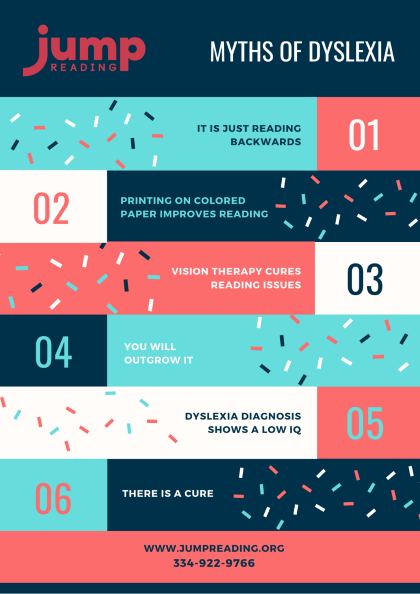Blog #8
Myths of Dyslexia

Understanding the difference between the myths and facts of dyslexia can be confusing.
Dyslexia in children is common. It is also commonly misunderstood. Today there is significant research evidence and many resources to help us understand this learning difference. But myths and unhelpful treatment suggestions still exist. So, let’s look at what dyslexia is and what it is not.

1. It Is Just Reading Backwards
This widespread myth is the most common because many children reverse letters when reading or writing. Dyslexia does not cause words to appear differently.
Dyslexia is a phonological processing disorder. It is a difficulty connecting sounds with letters or groups of letters. Because of poor phonological processing, students lack phonemic awareness.
Phonemic awareness is the ability to isolate and manipulate a single sound within a word. A child might read the word “cat” and say “tac”. So, when the student reads, they may struggle to keep sounds in place. They are just proud to have said all the sounds, regardless of the order.
Students confuse b, d, p, and q, because they are all bubbles with stems. Dyslexia causes directionality deficits. Directionality like “left” and “right” are particularly challenging.
2. Printing Words on Colored Paper Improves Reading
Children with dyslexia will not benefit from colored paper or colored lenses. This myth comes from a different condition known as scotopic sensitivity.
Students who have scotopic or light sensitivity respond to color therapy. Starkly contrasting colors like black and white can appear to be moving. Reading is difficult if the words or letters move, or wave on the page. Colored overlay, lenses, or paper help the light sensitivity and words stop moving on the page. This condition is unrelated to dyslexia.
3. Vision Therapy Cures Reading Issues
Dyslexia is completely unrelated to eyesight issues. This myth comes from other physical conditions in which students eyes do not move simultaneously.
Vision therapy addresses eye muscles. It does not correct a dyslexia because vision therapy has no neurological impact. Dyslexia is a neurologically based learning difference. Dyslexia lives in the brain.
4. You Will Outgrow It
“It just clicked one day. I outgrew it.” Children with dyslexia can become independent readers with intervention, but they do not outgrow it.
Typically, a dyslexic child struggling to read in first grade will still be struggling in the eighth grade. For these child, reading and spelling never “just click.” For them to become fluent readers requires intervention and explicit instruction.
In general, people learn and progress more quickly in their early years. But it is never too late get intervention.
5. Dyslexia Diagnosis Shows a Low IQ
This is the most harmful myth. Dyslexia is not related to intelligence.
The myth comes from the assumption that reading, like speaking, is learned naturally. Reading is not a natural process. Reading must be taught. We are not born readers. In our educational world, reading is commonly accepted as an “every person” skill. Therefore, if you can’t read, you must not be smart. False, false, false. In fact, most reports show that the IQ could not be properly scored because of the reading deficit, which has pulled the average of the subtests down.
In reviewing test results, it is important to focus on the child’s learning potential versus achievement gap. A substantial gap indicates that intervention is needed. Simply put, if the intelligence is high and the reading is low, students can learn to read using Orton-Gillingham instruction.
The ability to read is not a reflection of critical thinking, deep comprehension, or creative problem solving abilities. All of these abilities reflect intelligence. They are also strengths associated with dyslexia. We know the child is smart.
6. There Is a Cure
Dyslexia is not a medical condition. There is no medication for it. It is a neurological condition, which responds to intervention. There is no cure.
The brain can be trained to process language if it is taught. The most successful “retraining” is consistent, systematic, explicit instruction taught in a multi-sensory manner.
Students with dyslexia can become proficient readers, spellers, and academically successful. But, they will still be students with dyslexia.
Successful intervention gives many families and students a feeling of “being cured”. Once a dyslexic, always a dyslexic. And, frankly, that is not bad. Let’s destigmatize dyslexia.
Learn more about dyslexia, myths, intervention, and resources. Visit the International Dyslexia Association (IDA) website. IDA is designed to help parents and educators. It publishes credible information regularly.
